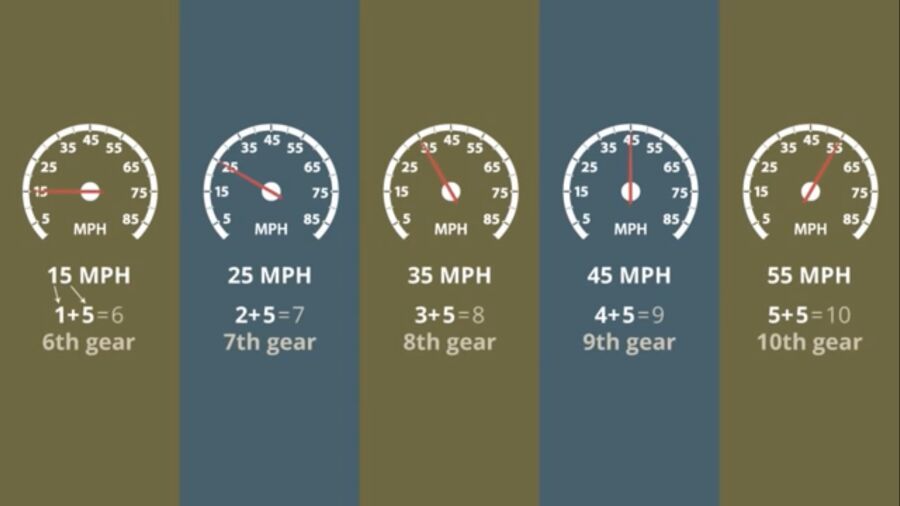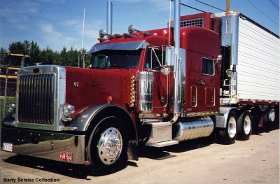Should I Be Concerned If I Never Drove A 10 Speed But Got My CDL A In A 6 Speed?
Topic 31832 | Page 1

They are not the same. I’d cram by looking at You Tube videos on shifting a manual 10-speed.
Went for an interview today and their tractor is a 10 speed. I only drove 6 speeds and they wanna do a road test with me tomorrow. Should I be concerned?
Did you let them know you haven't driven a 10 speed before? They may be more lenient if you let them know your only experience was a 6 speed. You demonstrated to the state you can operate a manual its just a matter of learning the shifting pattern for the 10 speed. Easiest way is for your higher gears add the digits together (15 mph is 6th, 25 is 7th etc.) It may not be perfect but it's close enough to give you a ball park range. When I attended school learning on a 10 speed we started in 4th gear and came to a stop in 6th. Of course the higher you start the easier it is to stall. Some drivers prefer to start out in 1st gear even empty it just gets trickier in my opinion because the speed for each gear is so close.
Check out this video, helped me tremendously in training. Its how to double clutch/shift a 10 speed!!
https://youtu.be/z6AKaBeRNU8

Double Clutch:
To engage and then disengage the clutch twice for every gear change.
When double clutching you will push in the clutch, take the gearshift out of gear, release the clutch, press the clutch in again, shift the gearshift into the next gear, then release the clutch.
This is done on standard transmissions which do not have synchronizers in them, like those found in almost all Class A trucks.

Did you let them know you haven't driven a 10 speed before? They may be more lenient if you let them know your only experience was a 6 speed. You demonstrated to the state you can operate a manual its just a matter of learning the shifting pattern for the 10 speed. Easiest way is for your higher gears add the digits together (15 mph is 6th, 25 is 7th etc.) It may not be perfect but it's close enough to give you a ball park range. When I attended school learning on a 10 speed we started in 4th gear and came to a stop in 6th. Of course the higher you start the easier it is to stall. Some drivers prefer to start out in 1st gear even empty it just gets trickier in my opinion because the speed for each gear is so close.
They didn’t ask but when he was showing me around I quickly glanced at the truck behind his back to see. I pretty much know the theory behind 10 speeds but haven’t actually drove one. Maybe he’ll teach me since he said most of the time I’m going to be driving automatic straight trucks
OWI:
Operating While Intoxicated

They are not the same. I’d cram by looking at You Tube videos on shifting a manual 10-speed.
Went for an interview today and their tractor is a 10 speed. I only drove 6 speeds and they wanna do a road test with me tomorrow. Should I be concerned?
I’ve been watching and actually scheduled some lessons at the end of this month. I know the theory behind it but haven’t actually drove one. I’m just going to go in confident.
Sorry if this is an ignorant comment lol, but was the 6 speed you tested in a non-synchronized transmission? (i.e. did you have to double clutch in it?) The shift patterns aren't that hard to learn and the main difference is going to be that you won't let the rpms drop as much between shifts in the 10 speed since there are more gears. As long as you already know how to double clutch or float gears it shouldn't be hard to adjust.
Float Gears:
An expression used to describe someone who is shifting gears without using the clutch at all. Drivers are taught to "Double Clutch" or press and release the clutch twice for each gear shift. If you're floating gears it means you're simply shifting without using the clutch at all.
Double Clutch:
To engage and then disengage the clutch twice for every gear change.
When double clutching you will push in the clutch, take the gearshift out of gear, release the clutch, press the clutch in again, shift the gearshift into the next gear, then release the clutch.
This is done on standard transmissions which do not have synchronizers in them, like those found in almost all Class A trucks.
Plus the Hi/Lo selection in there. It's mainly hitting the proper RPMs and clutching correctly, ie not too deep on the pedal.
Downshifting will be the biggest issue.

Sorry if this is an ignorant comment lol, but was the 6 speed you tested in a non-synchronized transmission? (i.e. did you have to double clutch in it?) The shift patterns aren't that hard to learn and the main difference is going to be that you won't let the rpms drop as much between shifts in the 10 speed since there are more gears. As long as you already know how to double clutch or float gears it shouldn't be hard to adjust.
No I didn’t double clutch
Float Gears:
An expression used to describe someone who is shifting gears without using the clutch at all. Drivers are taught to "Double Clutch" or press and release the clutch twice for each gear shift. If you're floating gears it means you're simply shifting without using the clutch at all.
Double Clutch:
To engage and then disengage the clutch twice for every gear change.
When double clutching you will push in the clutch, take the gearshift out of gear, release the clutch, press the clutch in again, shift the gearshift into the next gear, then release the clutch.
This is done on standard transmissions which do not have synchronizers in them, like those found in almost all Class A trucks.
No I didn’t double clutch
Oh ok yeah then you'll need that practice you signed up for. Since it's not a DOT road test just a company road test they won't mind if you float gears if that ends up being easier for you but you will have to learn how to match the road speed and rpms just right since it's a different animal in a non-synchronized tranny.
Let us know how it goes
Float Gears:
An expression used to describe someone who is shifting gears without using the clutch at all. Drivers are taught to "Double Clutch" or press and release the clutch twice for each gear shift. If you're floating gears it means you're simply shifting without using the clutch at all.
DOT:
Department Of Transportation
A department of the federal executive branch responsible for the national highways and for railroad and airline safety. It also manages Amtrak, the national railroad system, and the Coast Guard.
State and Federal DOT Officers are responsible for commercial vehicle enforcement. "The truck police" you could call them.
Double Clutch:
To engage and then disengage the clutch twice for every gear change.
When double clutching you will push in the clutch, take the gearshift out of gear, release the clutch, press the clutch in again, shift the gearshift into the next gear, then release the clutch.
This is done on standard transmissions which do not have synchronizers in them, like those found in almost all Class A trucks.
New Reply:
New! Check out our help videos for a better understanding of our forum features

















Preview:
This topic has the following tags:
Advice For New Truck Drivers Becoming A Truck Driver Tips For Shifting Truck Driver Salary







 TT On Facebook
TT On Facebook
Went for an interview today and their tractor is a 10 speed. I only drove 6 speeds and they wanna do a road test with me tomorrow. Should I be concerned?